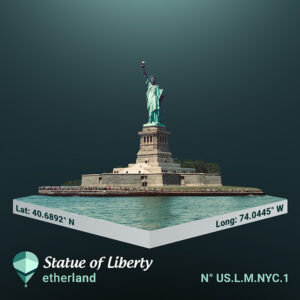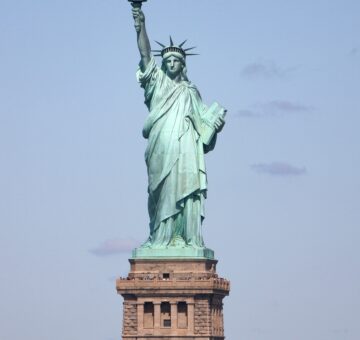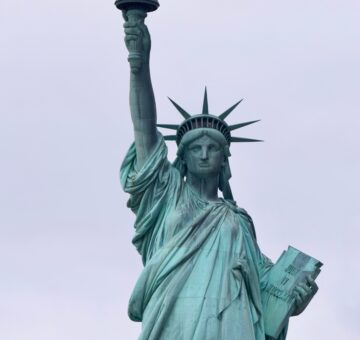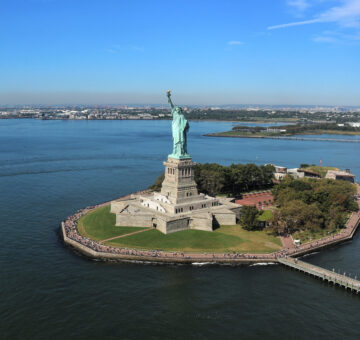Statue of liberty
 This monument was a gift from the people of France to the United States to commemorate their alliance during the American Revolution that took place from 1775 to 1783. The Statue of Liberty, also called Liberty Enlightening the World, is regarded as a universal embodiment of freedom and democracy. She holds a torch above her head as a symbol of enlightenment, showing the path to freedom, while holding with her left hand the tablet of law, on which is written in roman numerals the date of the American Independence: July 4, 1776. As the immigrants were arriving in America and debarked from the boats to a nearby station on Ellis Island, over 12 million of newcomers were welcomed to their new land by the tall lady and her flamboyant torch throughout the years. Nowadays, the statue of liberty receives over 4 million visitors per year, cementing its place as one of the most iconic landmarks in the world.
This monument was a gift from the people of France to the United States to commemorate their alliance during the American Revolution that took place from 1775 to 1783. The Statue of Liberty, also called Liberty Enlightening the World, is regarded as a universal embodiment of freedom and democracy. She holds a torch above her head as a symbol of enlightenment, showing the path to freedom, while holding with her left hand the tablet of law, on which is written in roman numerals the date of the American Independence: July 4, 1776. As the immigrants were arriving in America and debarked from the boats to a nearby station on Ellis Island, over 12 million of newcomers were welcomed to their new land by the tall lady and her flamboyant torch throughout the years. Nowadays, the statue of liberty receives over 4 million visitors per year, cementing its place as one of the most iconic landmarks in the world.
The Statue of Liberty, also called Liberty Enlightening the World, is regarded as a universal embodiment of freedom and democracy. The robed woman is a representation of Libertas, the Roman goddess and personification of liberty. With her right hand, she holds a torch above her head as a symbol of enlightenment, showing the path to freedom, while holding with her left hand the tablet of law.
This monument was meant to be a gift from France's people to the United States to commemorate their alliance during the American Revolution that took place from 1765 to 1783. More than a symbolic gesture, Edouard René de Laboulaye, a French political thinker, thought offering the statue would inspire his own people to create their own democracy and stand against the current will to re-establish monarchy.
The French sculptor Frédéric Auguste Bartholdi, on a trip to New York to suggest the construction of the statue to influential Americans, quickly saw Bedloe’s Island as the ideal location, as it was on the path of every ship that needed to enter New York. Bartholdi then headed back to France to design the statue’s appearance, while the engineer who made the Eiffel Tower, Gustave Eiffel, designed its metal framework and made it one of the first curtain-wall structures ever built. The parts were made in France then transported to the United States via ships and assembled on Bedloe’s Island.
The funds for the construction were raised from across the French society, mainly through donation and lottery ticket sales, cumulating a total amount of 1 million francs. However, the Americans were responsible for building the monument's base, raising $250 000 themselves, for a nowadays worth of over 2 million dollars. The Statue of Liberty was inaugurated in 1886 by President Grover Cleveland and Bedloe's Island was later renamed Liberty Island in 1956.
The vision of Bartholdi to place the statue on Bedloe’s Island had a big impact on America’s image. Indeed, over 12 million immigrants were welcomed to their new land by the tall lady and her flamboyant torch throughout the years, being the first symbol of America they would ever lay their eyes on.
Being one of the largest of its kind, the statue itself is 46 meters tall (151 ft.), adding the concrete foundation for a total of 93 meters (305 ft.). 31 tons (62 000 lbs.) of copper and 125 tons (250 000 lbs.) of steel were needed for both the exterior and the framework, respectively. Originally the sculpture's colour was a reddish-brown, but with time the copper oxidized and turned green. The monument underwent two major restorations in 1936 and 1986. Since then, many modification and improvement were made, but most of them were cosmetic changes.
You can now access many exhibits and tours on-site. In fact, the statue of liberty receives over 4 million visitors each year, cementing its place as one of the world's most iconic landmarks.





